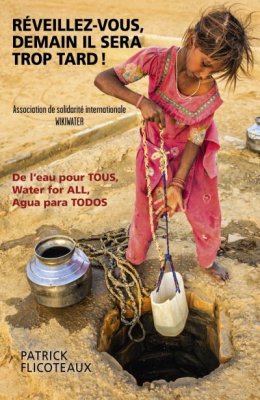1) What is involved ?
When deciding on a drinking water catchment and distribution project, it is important to create a lasting solution for the needs of the population in question. Any project must therefore undergo a preliminary analysis of the relevance of technical aspects, the work and maintenance costs and financing method along with its management method. The purpose of this sheet is to assist any project initiator to draw up a sort of checklist of questions to be raised before launching a drinking water supply project. It is targeting especially populations in rural areas, small urban areas and peri-urban districts.
2) Why ?
Any drinking water supply project must make sufficient quantity and quality of drinking water accessible to cover the basic needs of the population at an affordable price for the population in question. Good technical design, suitable financing and installing an efficient management method are the prerequisites in achieving objectives.
3) What do these recommendations involve ? How to design the most suitable project ?
Technical, financial and sociological criteria govern the choice of infrastructures. These three aspects combine to select the best solution that is technically feasible, financially possible (construction and servicing) and accepted by the community.
a) Preliminary questions before creating a project
Before creating a project and examining its technical, economic and social aspects, it is important to set out the framework and outlines by asking the following preliminary questions :
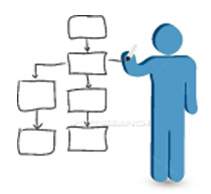 - Who is behind the project ? : this involves trying to highlight the project "sponsors", i.e. the people or institutions who launched the idea, who made the first contacts, etc. It is useful to know that they are really are the population’s representatives and authorised to intervene on its behalf.
- Who is behind the project ? : this involves trying to highlight the project "sponsors", i.e. the people or institutions who launched the idea, who made the first contacts, etc. It is useful to know that they are really are the population’s representatives and authorised to intervene on its behalf.
- What are the main needs of the commune or district ? : Does it involve, for example, supplying water for domestic use (drinking, washing, personal hygiene), water used in the fields for the cattle or for agriculture (irrigation, market gardening, food crops, etc.) ? What flow rate is required ? What bacteriological quality is required ?
It is important to analyse very carefully what the future facilities will be used for and where they must be created, for water points are built differently according to their future use and a single solution can rarely cover all eventualities.
- What needs are already covered and which still have to be satisfied ? Most villages already have a hydraulic system that needs improving rather than replacing. Understanding clearly what already exists and current practices frequently prevents errors or pointless expenditure.
- Is the project in line with the national water policy ? : It is important for any new facility to comply with the national policy and contribute to its development. This therefore requires acquiring information to understand it better, as only combined, overall action gives a State any chance of success.
It is also essential to understand the regulations, recommendations or regional uses in terms of constructing or choosing hydraulic facilities (boreholes, pumps, water point regulations aiming to prevent over-exploiting the water tables especially). Lastly, it is essential to think about obtaining the preliminary permissions.
- What price are the residents prepared to pay ? : There is absolutely no point in designing and creating a costly facility without at least a relatively accurate idea of the population’s financial capability and what it is prepared to finance in terms of both its construction and its maintenance.
b) Technical aspects
Preliminary investigations :
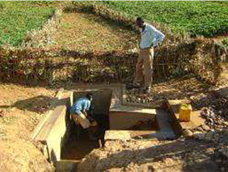
Harnessing springs in Burundi. Photo Caritas
The following technical aspects must be studied in advance before selecting the catchment method or equipment :
- The rainfall and rain characteristics
- The amount of water required
- The available water resources, their quality and their reliability
- The number of water sources, if any, and their location
- The type of soil
- The level of the water table
- The risks of damage to the environment
- The characteristics of the population and its water requirements
- The expectations of local technical departments
Analysing these characteristics, their cost, the motivation and how the population is organised and participates produces a comparative study of solutions and feasibility. It is advisable to seek help if the project is large or at least have it validated by specialists.
This study, which must be supplemented by a socio-economic analysis, will highlight mainly :
What solutions can be envisaged ? Which technical solution is preferable ? Which furthermore seems the best for the population ? How should the equipment relating to the proposed type of facility be chosen ? How can its maintenance and availability of spare parts be guaranteed ?
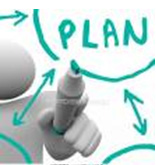 The main decision-making criteria will be :
The main decision-making criteria will be :
- The expected level of service
- The quality and longevity of the equipment
- The investment and maintenance costs
- The existence and level of local available skills
- The ease of use and servicing
- The population and commune’s ability to pay
The table below gives the orders of magnitude of the cost (in euros) of a few common investments :
| Harnessing a spring without gravity network | Well with manual pump | Borehole with manual pump | Motor-driven borehole | Simple network with standpipes | Network with individual connections | |
| Initial investment | 600 à 1000 | 5,000 to 8,000 | 10 to 12,000 | 20 to 30,000 | 100 to 300,000 | 150 to 500,000 |
| Invest. cost per inhabitant | 2 to 4 | 20 to 30 | 35 to 40 | 50 to 75 | 80 to 120 | 150 to 200 |
| Annual maintenance | cost negligible | 40 to 70 | 40 to 70 | 1,000 to 1,500 | 2,000 to 5,000 | 8 to 15,000 |
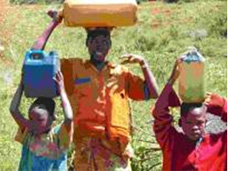
Photo Caritas Burundi
Analysis of water requirements and necessary flow rates :
The first consideration is the demography and population distribution : number of inhabitants to be supplied, population density and anticipated growth.
The second is assessing the daily water consumption by taking account of domestic consumption (current average consumption of one family and any forecast population growth) and agricultural or artisan consumption.
Example :
It is generally agreed that the consumption required to give a developing country its basic needs is at least 20 litres per day and per inhabitant. In this case, if a village has a population of 2,000 people, the resource must be capable of supplying 40,000 litres a day (or 40 m3). As consumption is not continuous (night or technical problem), the maximum predictable instantaneous consumption must be taken into account. Let us assume that a continuous supply must be provided for eight hours. The instantaneous flow rate produced by the resource should be at least 40,000 litres/8 hours, i.e. 5,000 litres an hour. To this must be added the estimated water losses in the pipes (about +10% to 20%), which can in fact be greater depending on pipe lengths and condition. It would therefore in this example be wise to predict a minimum capacity of 5 to 6 m3/h and if possible a far greater capacity, as 20 l/d/inhabitant is the strict minimum.
This is only an example. Each town or village should set its own design criteria based on the water distribution method and its own needs, in particular whether provision must be made to supply a watering place for animals, vegetable gardens and irrigation systems.
In the case of a spring or a borehole fitted with a motor-driven pump, the instantaneous flow rate for continuous operation may be reduced by installing a tank.
Choosing where the water resource comes from and how it is harnessed :
The water can be harnessed from a spring or well (groundwater) or from a river or lake (surface water). Harnessing spring water is normally the most economical solution and can sometimes allow a gravity supply without pumping. Where there is no spring, a well or borehole will have to be dug and fitted with a manually- or motor-driven pump. In most cases, the groundwater can be consumed without special treatment apart from disinfection. Nevertheless, the water can be cloudy after a period of heavy rain.
Water from a river or lake must be used when there is not enough groundwater from a spring or the water table. The infrastructures to be built are then more complex and must include a water intake, a pumping station and a filtering system which may be preceded by a settling tank.
- Water supply method to the population and public buildings :
The water consumption of each inhabitant depends strongly on how he is supplied and his standard of living. Consumption will vary hugely between a person living in a town with lavatories and a person living in a rural area who has to collect water from the spring or a standpipe. The number and location of standpipes must be based on the location of communities to be supplied.
 Choosing the equipment
Choosing the equipment
This is very important, as many items of equipment such as pumps break down if not up to the task. The equipment must however be simple to use, easy to keep in good condition and well suited to the local conditions.
The recommended harnessing technologies are those already proven in the region ; local labour and local equipment and materials can therefore be used.
It is therefore wise to choose equipment that has already been used successfully in the region ; competent repairers can be found not far away along with spare parts.
c) Economic aspects
The technical criteria are used to determine the possible solution(s). The costs relating to each option retained (preliminary studies, investment in infrastructure construction and operating costs) must then be assessed and the financing method sought.
Both the cost of the equipment itself and of maintaining it must be calculated.
Lastly, it can often be useful to relate this cost to the number of future users and/or to calculate it per cubic metre, if only for comparison with other potential systems and similar constructions in the area or to produce an aid request package for a lending institution or permit application to the local authorities.
Infrastructures are normally financed from public funds, but some funding can come from an NGO, public foreign aid or population participation. The population is responsible for the operating and servicing costs. It must be able to support these costs and ensure the viability and longevity of the project.
d) Social aspects
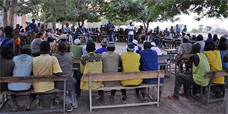
Information and consultation meeting with villagers
The criteria to be taken into account when making the final choice of the technology are social as well as technical and financial. It is in fact essential to take into account the opinions and skills of the population. The following aspects must therefore be considered :
- The level of local interest in improving the water supply situation
- The type of communal organisation that already exists or has to be created.
- The level of cohesion between the communities.
- Any possibilities of dispute or opposition.
- The possibilities of local labour input.
- The types of skill available in the communities.
- The possibility of a contribution in cash or in kind (participation in the work, supplies, etc.)
The communities must become involved as early as possible and must be able to make informed decisions as to their participation, the level of services and how they are implemented.
It is a good idea to create a temporary management committee or user association (see sheets C6 to C8) which will provide communities with information on the content, the financial implications and the maintenance of different options. This committee would also be responsible for setting up the final management structure in charge of maintenance and for initiating or continuing to train the population in the hygiene and health rules.
e) Organising the work
 Before work starts, the site must be organised around the following questions :
Before work starts, the site must be organised around the following questions :
- Who should be chosen or confirmed as principle and thus the effective owner, will decide or confirm the solution retained, will provide the necessary funds, ensure compliance with the regulations, set the tariffs and the use regulations, place the orders and accept the work ?
- Who should be chosen as project manager and thus will coordinate the various trades on the site and compliance with the work executed with what has been planned ? A State or regional technical department ? someone from the village ? or a local private contractor ? (the most frequent and advisable solution)
- Who will be responsible for inspecting the work ? A Design Office or independent service ? Someone nominated by the lending institution ? With the support or participation of local official technical departments ?
4) Where to obtain further information
- PS Eau (Water Solidarity Programme). It has published two guides in particular :
- a Guide to creating a drinking water project, which outlines in very detailed pages the four major steps in the process and the 18 questions to be asked
http://www.pseau.org/outils/biblio/resume.php ?docu_document_id=3388
New and more detailed publication (2014, 96 pages):
http://www.pseau.org/outils/ouvrage...
 - a second guide in the form of a 29-page illustrated slide show Designing and creating a water and sanitation project. It was produced as a training module in Rennes for NGOs in Burkina Faso, but in fact covers all countries. The guide outlines especially six key stages and seven quality criteria
- a second guide in the form of a 29-page illustrated slide show Designing and creating a water and sanitation project. It was produced as a training module in Rennes for NGOs in Burkina Faso, but in fact covers all countries. The guide outlines especially six key stages and seven quality criteria
http://www.mirennes.fr/dyn/fic/publ...
- Interaide : This NGO has published two documents :
- The first is The distribution system, a few principles regarding the operation and design This sixteen-page brochure covers more especially the creation of gravity network water distribution systems. It aims to provide an understanding of such networks and it mainly gives useful indications on such hydraulic phenomena as head loss, the piezometric line, water hammer, etc. as well as information on how to design and dimension a project
http://www.interaide.org/pratiques_...
- The second is a two-page summarised checklist, that gives all the documents to be produced and the data to be sought when preparing and executing a project.
http://www.interaide.org/pratiques/...
- TERRE VIVANTE : Tektaka, a project to fight poverty in Southern Africa and the Karakoro.
A work of some forty pages published in 2004 going beyond the single context of a village and pastoral hydraulic programme in this village of 8,300 inhabitants. It addresses the methodology adopted to give this commune, with the active participation of the population, a genuine integrated development plan to ensure its long-term progress and which includes a range of objectives - hydraulic, agriculture, health, education, market gardening, fishing, arboriculture, transport, arts and crafts and common action.
https://operations.ifad.org/documents/654016/a408895c-857c-49b3-9454-d98cdc4911d2
- WATERAID. This three-page document Considerations before design states more especially the numerous problems, not just technical ones, that must be considered when designing a project and in particular what must be done with the population and villager committees.
https://washmatters.wateraid.org/sites/g/files/jkxoof256/files/Technology%20notes.pdf



